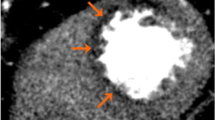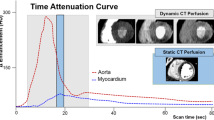Abstract
Multidetector CT angiography (MDCTA) has become an accurate, noninvasive test for the diagnosis of coronary atherosclerosis. Studies have established a good sensitivity and an excellent negative predictive value for the diagnosis of coronary stenoses of 50% or greater severity. However, MDCTA is more limited in patients with disease with a lower specificity and positive predictive value for predicting atherosclerosis causing myocardial ischemia. Although radionuclide myocardial perfusion imaging (MPI) has been the mainstay for evaluating the presence of myocardial ischemia and scar in patients at risk for coronary artery disease, contrast-enhanced multidetector CT (MDCT) alone, with or without vasodilator stress, has the potential to provide both anatomical and functional information on coronary atherosclerosis and its impact on myocardial perfusion. We review the current status of MDCT MPI, including its advantages, limitations, and pitfalls.
Similar content being viewed by others
References and Recommended Reading
Leber AW, Knez A, von Ziegler F, et al.: Quantification of obstructive and nonobstructive coronary lesions by 64-slice computed tomography: a comparative study with quantitative coronary angiography and intravascular ultrasound. J Am Coll Cardiol 2005, 46:147–154.
Leschka S, Alkadhi H, Plass A, et al.: Accuracy of MSCT coronary angiography with 64-slice technology: first experience. Eur Heart J 2005, 26:1482–1487.
Mollet NR, Cademartiri F, Nieman K, et al.: Multislice spiral computed tomography coronary angiography in patients with stable angina pectoris. J Am Coll Cardiol 2004, 43:2265–2270.
Raff GL, Gallagher MJ, O’Neill WW, et al.: Diagnostic accuracy of noninvasive coronary angiography using 64-slice spiral computed tomography. J Am Coll Cardiol 2005, 46:552–557.
Motoyama S, Anno H, Sarai M, et al.: Noninvasive coronary angiography with a prototype 256-row area detector computed tomography system: comparison with conventional invasive coronary angiography. J Am Coll Cardiol 2008, 51:773–775.
Steigner ML, Otero HJ, Cai T, et al.: Narrowing the phase window width in prospectively ECG-gated single heart beat 320-detector row coronary CT angiography. Int J Cardiovasc Imaging 2008 Jul 29 (Epub ahead of print).
Rybicki FJ, Otero HJ, Steigner ML, et al.: Initial evaluation of coronary images from 320-detector row computed tomography. Int J Cardiovasc Imaging 2008, 24:535–546.
Ropers D, Pohle FK, Kuettner A, et al.: Diagnostic accuracy of noninvasive coronary angiography in patients after bypass surgery using 64-slice spiral computed tomography with 330-ms gantry rotation. Circulation 2006, 114:2334–2341; quiz 2334.
Cordeiro MA, Miller JM, Schmidt A, et al.: Non-invasive half millimetre 32 detector row computed tomography angiography accurately excludes significant stenoses in patients with advanced coronary artery disease and high calcium scores. Heart 2006, 92:589–597.
Gaspar T, Halon DA, Lewis BS, et al.: Diagnosis of coronary in-stent restenosis with multidetector row spiral computed tomography. J Am Coll Cardiol 2005, 46:1573–1579.
Ehara M, Kawai M, Surmely JF, et al.: Diagnostic accuracy of coronary in-stent restenosis using 64-slice computed tomography: comparison with invasive coronary angiography. J Am Coll Cardiol 2007, 49:951–959.
Uren NG, Melin JA, De Bruyne B, et al.: Relation between myocardial blood flow and the severity of coronary-artery stenosis. N Engl J Med 1994, 330:1782–1788.
White CW, Wright CB, Doty DB, et al.: Does visual interpretation of the coronary arteriogram predict the physiologic importance of a coronary stenosis? N Engl J Med 1984, 310:819–824.
Hachamovitch R, Hayes SW, Friedman JD, et al.: Comparison of the short-term survival benefit associated with revascularization compared with medical therapy in patients with no prior coronary artery disease undergoing stress myocardial perfusion single photon emission computed tomography. Circulation 2003, 107:2900–2907.
Iskandrian AS, Chae SC, Heo J, et al.: Independent and incremental prognostic value of exercise single-photon emission computed tomographic (SPECT) thallium imaging in coronary artery disease. J Am Coll Cardiol 1993, 22:665–670.
Schuijf JD, Wijns W, Jukema JW, et al.: Relationship between noninvasive coronary angiography with multislice computed tomography and myocardial perfusion imaging. J Am Coll Cardiol 2006, 48:2508–2514.
Hacker M, Jakobs T, Matthiesen F, et al.: Comparison of spiral multidetector CT angiography and myocardial perfusion imaging in the noninvasive detection of functionally relevant coronary artery lesions: first clinical experiences. J Nucl Med 2005, 46:1294–1300.
Rispler S, Keidar Z, Ghersin E, et al.: Integrated single-photon emission computed tomography and computed tomography coronary angiography for the assessment of hemodynamically significant coronary artery lesions. J Am Coll Cardiol 2007, 49:1059–1067.
Stewart GN: Researches on the circulation time and on the influences which affect it. IV. The output of the heart. J Physiol 1897, 22:159.
Hamilton WF, Moore JW, Kinsman JM, et al.: Studies on the circulation. IV. Further analysis of the injection method and of changes in hemodynamics under physiological and pathological conditions. Am J Physiol 1932, 99:534.
Rumberger JA, Bell MR: Measurement of myocardial perfusion and cardiac output using intravenous injection methods by ultrafast (cine) computed tomography. Invest Radiol 1992, 27(Suppl 2):S40–S46.
Rumberger JA, Feiring AJ, Lipton MJ, et al.: Use of ultrafast computed tomography to quantitate regional myocardial perfusion: a preliminary report. J Am Coll Cardiol 1987, 9:59–69.
Kitagawa K, George RT, Chang HJ, et al.: Myocardial perfusion assessment using dynamic-mode 256-row multidetector computed tomography: influence of beam hardening correction. J Cardiovasc Comput Tomogr 2008, In press.
Newhouse JH, Murphy RX Jr: Tissue distribution of soluble contrast: effect of dose variation and changes with time. AJR Am J Roentgenol 1981, 136:463–467.
Newhouse JH: Fluid compartment distribution of intravenous iothalamate in the dog. Invest Radiol 1977, 12:364–367.
Canty JM Jr, Judd RM, Brody AS, et al.: First-pass entry of nonionic contrast agent into the myocardial extravascular space. Effects on radiographic estimates of transit time and blood volume. Circulation 1991, 84:2071–2078.
George RT, Silva C, Ichihara T, et al.: Perfusion imaging during first-pass contrast-enhanced helical multi-detector computed tomography. Int J Cardiovasc Imaging 2006, 22(Suppl 1):22–23.
Axel L: Tissue mean transit time from dynamic computed tomography by a simple deconvolution technique. Invest Radiol 1983, 18:94–99.
Christian TF, Rettmann DW, Aletras AH, et al.: Absolute myocardial perfusion in canines measured by using dual-bolus first-pass MR imaging. Radiology 2004, 232:677–684.
Gould RG, Lipton MJ, McNamara MT, et al.: Measurement of regional myocardial blood flow in dogs by ultrafast CT. Invest Radiol 1988, 23:348–353.
Wolfkiel CJ, Ferguson JL, Chomka EV, et al.: Measurement of myocardial blood flow by ultrafast computed tomography. Circulation 1987, 76:1262–1273.
Wang T, Wu X, Chung N, Ritman EL: Myocardial blood flow estimated by synchronous, multislice, high-speed computed tomography. IEEE Trans Med Imaging 1989, 8:70–77.
Bell MR, Lerman LO, Rumberger JA: Validation of minimally invasive measurement of myocardial perfusion using electron beam computed tomography and application in human volunteers. Heart 1999, 81:628–635.
Di Carli MF, Dorbala S, Curillova Z, et al.: Relationship between CT coronary angiography and stress perfusion imaging in patients with suspected ischemic heart disease assessed by integrated PET-CT imaging. J Nucl Cardiol 2007, 14:799–809.
Mori S, Kondo C, Suzuki N, et al.: Volumetric coronary angiography using the 256-detector row computed tomography scanner: comparison in vivo and in vitro with porcine models. Acta Radiol 2006, 47:186–191.
Kondo C, Mori S, Endo M, et al.: Real-time volumetric imaging of human heart without electrocardiographic gating by 256-detector row computed tomography: initial experience. J Comput Assist Tomogr 2005, 29:694–698.
Mahnken AH, Bruners P, Katoh M, et al.: Dynamic multi-section CT imaging in acute myocardial infarction: preliminary animal experience. Eur Radiol 2006, 16:746–752.
Daghini E, Primak AN, Chade AR, et al.: Evaluation of porcine myocardial microvascular permeability and fractional vascular volume using 64-slice helical computed tomography (CT). Invest Radiol 2007, 42:274–282.
George RT, Jerosch-Herold M, Silva C, et al.: Quantification of myocardial perfusion using dynamic 64-detector computed tomography. Invest Radiol 2007, 42:815–822.
Groves AM, Goh V, Rajasekharan S, et al.: CT coronary angiography: quantitative assessment of myocardial perfusion using test bolus data—initial experience. Eur Radiol 2008, 18:2155–2163.
Mohlenkamp S, Lerman LO, Lerman A, et al.: Minimally invasive evaluation of coronary microvascular function by electron beam computed tomography. Circulation 2000, 102:2411–2416.
George RT, Silva C, Cordeiro MA, et al.: Multidetector computed tomography myocardial perfusion imaging during adenosine stress. J Am Coll Cardiol 2006, 48:153–160.
George RT, Zadeh A, Kitagawa K, et al.: Adenosine stress 64 and 256 MDCT perfusion imaging: the transmural extent of perfusion abnormalities predicts atherosclerosis causing territorial ischemia. J Cardiovasc Comput Tomogr 2008, 2:S25.
Ruzsics B, Lee H, Zwerner PL, et al.: Dual-energy CT of the heart for diagnosing coronary artery stenosis and myocardial ischemia—initial experience. Eur Radiol 2008, 18:2414–2424.
George RT, Yousef O, Kitagawa K, et al.: Quantification of myocardial perfusion in patients using 256-row multidetector computed tomography: evaluation of endocardial vs. epicardial blood flow. Circulation 2007, 116:SII–563.
Author information
Authors and Affiliations
Corresponding author
Rights and permissions
About this article
Cite this article
George, R.T., Lardo, A.C. & Lima, J.A.C. Added value of CT myocardial perfusion imaging. curr cardiovasc imaging rep 1, 96–104 (2008). https://doi.org/10.1007/s12410-008-0015-0
Published:
Issue Date:
DOI: https://doi.org/10.1007/s12410-008-0015-0




